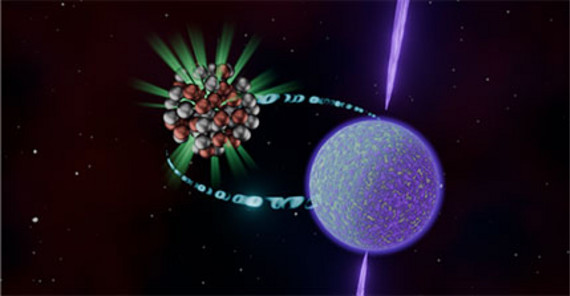Neutron star matter exists under the extreme pressures generated by the gravitational force of the neutron star. Due to these extreme pressures, the material reaches densities that go beyond that of atomic nuclei and thus cannot be studied easily in a laboratory. Instead, their properties are determined from astrophysical and nuclear-physical observations.
The PhD students Hauke Köhn and Henrik Rose in the Theoretical Astrophysics Group of Prof. Tim Dietrich have now jointly analyzed and combined several of these observations. Based on statistical investigations, the so-called equation of state of neutron star matter can be reconstructed to a certain extent.
“The equation of state describes the relationships between the relevant properties of matter like pressure and density. It has huge significance for our understanding of the strong force, one of the four fundamental interactions in nature,” describes Hauke Köhn. “When observing neutron stars or measuring a specific quantity from a nucleus, we only get one isolated data point.” In order to constrain the complicated behavior of the equation of state, these data points need to be combined. Therefore, the young researchers looked at a large set of theoretically possible candidates for the equation of state and then assessed statistically which of these fit the available data best.
Their results show that a typical neutron star will have a radius likely between 11.5 and 13.2 kilometers, and the upper mass limit for neutron stars is 2.5 times the mass of our sun. Depending on which data points are included in the analysis, even tighter limits can be obtained. “Yet, it remains rather challenging to actually constrain the true microscopic parameters of neutron star matter, like certain nuclear parameters,“ Henrik Rose comments and adds: “This tells us that further empirical observations from nuclear and astrophysics are needed to fully constrain the equation of state of neutron star matter in the future.“
Link to Publication: Hauke Koehn, Henrik Rose, Peter T. H. Pang, Rahul Somasundaram, Brendan T. Reed, Ingo Tews, Adrian Abac, Oleg Komoltsev, Nina Kunert et al., From Existing and New Nuclear and Astrophysical Constraints to Stringent Limits on the Equation of State of Neutron-Rich Dense Matter, Phys. Rev. X 15, DOI: https://doi.org/10.1103/PhysRevX.15.021014
Link to user Webtool: https://multi-messenger.physik.uni-potsdam.de/eos_constraints/
Image: Artistic representation of a neutron star and a nucleus. It symbolizes how knowledge about neutron stars can answer questions from nuclear physics and vice versa. Image: Hauke Köhn.
Contact:
Hauke Köhn, Institute of Physics and Astronomy
Tel.: +49 331 977-5983
E-Mail: hauke.koehnuuni-potsdampde

